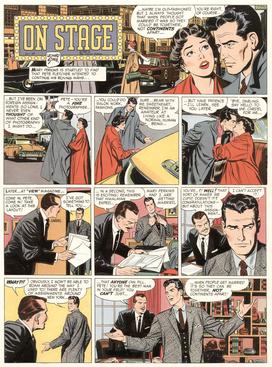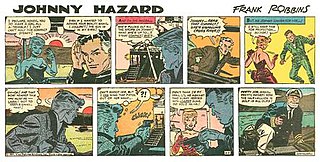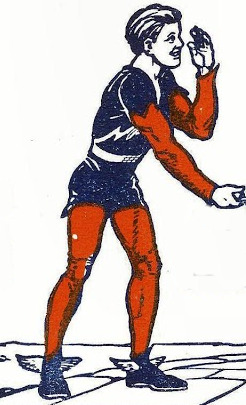Related Research Articles

Gasoline Alley is a comic strip created by Frank King and distributed by Tribune Content Agency. It centers on the lives of patriarch Walt Wallet, his family, and residents in the town of Gasoline Alley, with storylines reflecting traditional American values.
Disney comics are comic books and comic strips featuring characters created by the Walt Disney Company, including Mickey Mouse, Donald Duck and Uncle Scrooge.
Johnny Reb is the national personification of the common soldier of the Confederacy. During the American Civil War and afterwards, Johnny Reb and his Union counterpart Billy Yank were used in speech and literature to symbolize the common soldiers who fought in the Civil War in the 1860s. The symbolic image of Johnny Reb in Southern culture has been represented in its novels, poems, art, public statuary, photography, and written history. According to the historian Bell I. Wiley, who wrote about the common soldiers of the Northern and the Southern armies, the name appears to have its origins in the habit of Union soldiers calling out, "Hello, Johnny" or "Howdy, Reb" to Confederate soldiers on the other side of the picket line.

Quality Comics was an American comic book publishing company which operated from 1937 to 1956 and was a creative, influential force in what historians and fans call the Golden Age of Comic Books.

Steve Canyon is an American adventure comic strip by writer-artist Milton Caniff. Launched shortly after Caniff retired from his previous strip, Terry and the Pirates, Steve Canyon ran from January 13, 1947, until June 4, 1988. It ended shortly after Caniff's death. Caniff won the Reuben Award for the strip in 1971.

Mary Perkins, On Stage is an American newspaper comic strip by Leonard Starr for the Chicago Tribune-New York News Syndicate. It ran from February 10, 1957, to September 9, 1979, with the switch to the longer title in 1961. Some papers carried the strip under the shortened title Mary Perkins.
Yank may refer to:

George R. Evans was an American cartoonist and illustrator who worked in both comic books and comic strips. His lifelong fascination with airplanes and the pioneers of early aviation was a constant theme in his art and stories.
Billy Yank or Billy Yankee is the personification of the United States soldier during the American Civil War. The latter part of the name is derived from Yankee, previously a term for New Englanders, and possibly deriving from a term for Dutch settlers of New Netherland before that, extended by American Southerners to refer to Americans from above the Mason-Dixon Line. Although little evidence exists to suggest that the name was used widely during the Civil War, unlike its rebel counterpart Johnny Reb, early 20th century political cartoonists introduced 'Billy Yank' to symbolize U.S. combatants in the American Civil War of the 1860s.
Johnny Reb or Johnny Rebel is a slang term for Confederate soldiers in the American Civil War.
Michael Anglo was a British comic book writer, editor and artist, as well as an author. He is best known for creating the superhero Marvelman, later known as Miracleman.

Frank Giacoia was an American comics artist known primarily as an inker. He sometimes worked under the name Frank Ray, and to a lesser extent Phil Zupa, and the single moniker Espoia, the latter used for collaborations with fellow inker Mike Esposito.

The Sunday comics or Sunday strip is the comic strip section carried in most western newspapers. Compared to weekday comics, Sunday comics tend to be full pages and are in color. Many newspaper readers called this section the Sunday funnies, the funny papers or simply the funnies.
Comic strip formats vary widely from publication to publication, so that the same newspaper comic strip may appear in a half-dozen different formats with different numbers of panels, different sizes of panels and different arrangement of panels.

Carroll O. Wessler, better known as Carl Wessler, was an American animator of the 1930s and a comic book writer from the 1940s though the 1980s for such companies as DC Comics, EC Comics, Marvel Comics, and Warren Publishing.

Johnny Hazard is an action-adventure comic strip created by cartoonist Frank Robbins for King Features Syndicate. It was published from June 5, 1944, until August 20, 1977, with separate storylines for the daily strip and the Sunday strip.
Carl T. Pfeufer was an American comic-book artist, magazine illustrator, painter, and sculptor. He was an early contributor to American comic books; one of the primary early artists of the Marvel Comics superhero the Sub-Mariner; and the longtime artist of Western hero Tom Mix's comic books.

Jack Flash is a British adventure story character published in the British comic magazine The Beano, first appearing in issue 355 with artwork by Dudley Watkins. He featured for almost a decade in five serials, following his time as a foreigner to Earth and living in a Cornish village.
John Dixon was an Australian comic book artist and writer, best known for his comic strip creation, Air Hawk and the Flying Doctors.
References
The information for this article was obtained by direct reference to the Johnny Reb and Billy Yank comic strips.
- 1 2 Holtz, Allan (2012). American Newspaper Comics: An Encyclopedic Reference Guide. Ann Arbor: The University of Michigan Press. p. 217. ISBN 9780472117567.